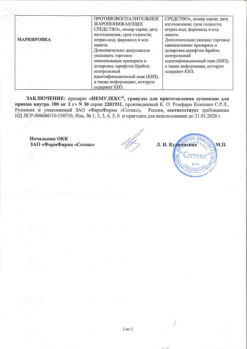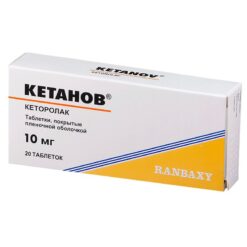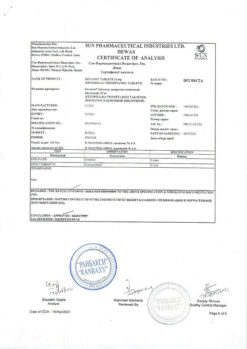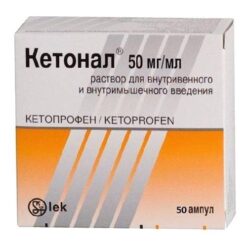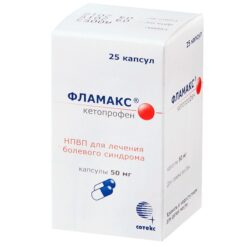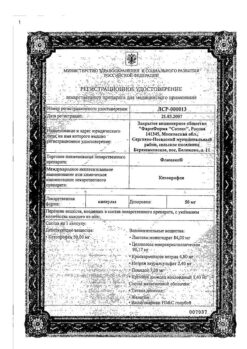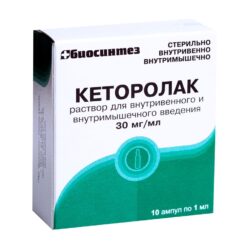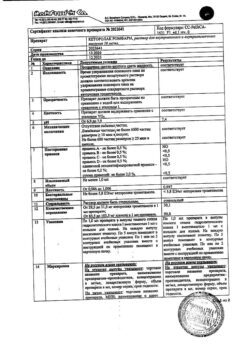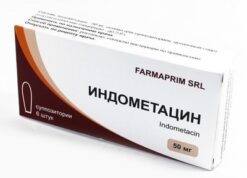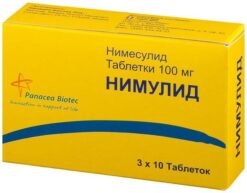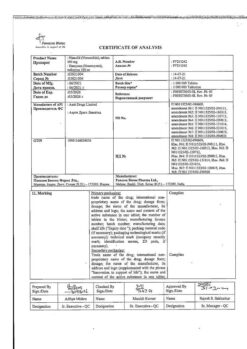No products in the cart.
Nemulex, 100 mg/2 g 2 g 4 pcs.
€6.43 €5.63
Description
Nimesulide
Indications
Indications
– Rheumatoid arthritis;
– Osteoarthrosis;
– Arthritis of various etiologies;
– Arthralgia;
– Myalgia;
– Postoperative and post-traumatic pain;
-Bursitis;
– Tendinitis;
– Algodismenorrhea;
– Toothache and headache.
The drug is intended for symptomatic therapy, reducing pain and inflammation at the time of use, and does not affect the progression of the disease.
Pharmacological effect
Pharmacological effect
Pharmacotherapeutic group: Non-steroidal anti-inflammatory drug.
ATX code: M01AX17
Pharmacological action
A nonsteroidal anti-inflammatory drug (NSAID) has anti-inflammatory, analgesic, antipyretic and antiplatelet effects. Unlike other NSAIDs, it selectively inhibits cyclooxygenase-2 (COX-2), inhibits the synthesis of prostaglandins (Pg) at the site of inflammation; has a less pronounced inhibitory effect on cyclooxygenase-1 (COX-1) (less likely to cause side effects associated with inhibition of Pg synthesis in healthy tissues).
Pharmacokinetics.
Absorption when taken orally is high (food intake reduces the rate of absorption without affecting its degree). Time to reach maximum concentration in blood plasma (T Cmax) is 1.5-2.5 hours. Communication with plasma proteins is 95%, with erythrocytes – 2%, with lipoproteins – 1%, with acidic alpha-glycoprotein – 1%. Changing the dose does not affect the degree of binding. Maximum concentration (Cmax) – 3.5-6.5 mg/l. Volume of distribution – 0.19-0.35 l/kg. Penetrates well into the acidic environment of the inflammation site (40%) and synovial fluid (43%). Easily penetrates histohematic barriers. Metabolized in the liver by tissue monooxygenases. The main metabolite, 4-hydroxynimesulide (25%), has similar pharmacological activity, but due to a decrease in molecular size, it is able to quickly diffuse through the hydrophobic COX-2 channel to the active binding site of the methyl group. 4-hydroxynimesulide is a water-soluble compound, the elimination of which does not require glutathione and conjugation reactions of phase II metabolism (sulfation, glucuronidation, etc.). The half-life (T1/2) of nimesulide is 1.56-4.95 hours, 4-hydroxynimesulide is 2.89-4.78 hours. 4-Hydroxynimesulide is excreted by the kidneys (65%) and bile (35%), and undergoes enterohepatic recirculation.
Special instructions
Special instructions
To reduce the risk of side effects, it is necessary to use the drug in the minimum effective dose for the shortest duration. If the patient’s condition does not improve, treatment should be stopped.
It is necessary to stop taking the drug if the temperature rises or flu-like symptoms develop while taking it.
If patients taking Nimesulide develop symptoms indicating liver damage (for example, anorexia, nausea, vomiting, abdominal pain, fatigue, dark urine), or increased levels of “liver” transaminases, the drug should be discontinued. It is not recommended to prescribe Nimesulide to such patients in the future.
Gastrointestinal bleeding or ulcer/perforation of the stomach or duodenum may develop at any time while using the drug, which may not be accompanied by clinically significant symptoms (including pain). If gastrointestinal bleeding or ulcers occur, the drug should be discontinued.
If renal function deteriorates, the drug should be discontinued.
If the drug is used for more than 2 weeks, monitoring of liver function indicators is necessary.
In patients with liver cirrhosis or renal failure with hypoalbuminemia or hyperbilirubinemia, nimesulide binding is reduced.
Elderly patients most often develop side effects when taking the drug, including gastrointestinal bleeding, perforation, dysfunction of the heart, kidneys and liver. Therefore, regular clinical monitoring of the patient’s condition is recommended.
The use of nimesulide may adversely affect female fertility and is not recommended for women planning pregnancy.
If, when using the drug, undesirable effects occur on the part of the central nervous system and sensory organs, it is necessary to refrain from driving vehicles and engaging in activities that require increased concentration and speed of psychomotor reactions.
Active ingredient
Active ingredient
Nimesulide
Composition
Composition
1 sachet of the drug contains:
active substance: nimesulide 100 mg;
excipients: macrogol cetostearate (Cremophor A25) – 100 mg, anhydrous citric acid – 19 mg, colloidal silicon dioxide (aerosil) -40 mg, sucrose – 1721 mg, orange flavor – 20 mg.
Contraindications
Contraindications
Hypersensitivity, complete or incomplete combination of bronchial asthma, recurrent polyposis of the nose or paranasal sinuses and intolerance to acetylsalicylic acid (ASA) and other NSAIDs (including a history), erosive and ulcerative lesions of the mucous membrane of the stomach and duodenum, active gastrointestinal bleeding, cerebrovascular or other bleeding, inflammatory bowel diseases (Crohn’s disease, ulcerative colitis) in the acute phase, hemophilia and other bleeding disorders, decompensated chronic heart failure (CHF), liver failure or any active liver disease, history of hepatotoxic reactions when using nimesulide, alcoholism, drug addiction, severe chronic renal failure (CRF) (creatinine clearance less than 30 ml/min), progressive diseases kidneys, confirmed hyperkalemia, period after coronary artery bypass surgery, simultaneous use of other hepatotoxic drugs (drugs), children under 12 years of age, pregnancy, breastfeeding period.
With caution.
Coronary heart disease (CHD), cerebrovascular diseases, CHF, dyslipidemia/hyperlipidemia, diabetes mellitus, peripheral arterial disease, smoking, renal failure (creatinine clearance less than 30-60 ml/min), anamnestic data on the development of ulcerative lesions of the gastrointestinal tract (GIT), presence of Helicobacter pylori infection, old age, long-term use of NSAIDs, severe somatic diseases, simultaneous use of anticoagulants (including warfarin), antiplatelet agents (including ASA, clopidogrel), oral glucocorticosteroids (GCS), selective serotonin reuptake inhibitors (including citalopram, fluoxetine, paroxetine, sertraline).
Side Effects
Side Effects
Allergic reactions: hypersensitivity reactions, anaphylactoid reactions. From the central nervous system: dizziness, feeling of fear, nervousness, nightmares, headache, drowsiness, encephalopathy (Reye’s syndrome).
From the skin: itching, skin rash, increased sweating, erythema, dermatitis, urticaria, angioedema, facial swelling, exudative erythema multiforme, including Stevens-Johnson syndrome, toxic epidermal necrolysis (Lyell’s syndrome).
From the urinary system: edema, dysuria, hematuria, urinary retention, hyperkalemia, renal failure, oliguria, interstitial nephritis.
From the gastrointestinal tract: diarrhea, nausea, vomiting, constipation, flatulence, gastritis, abdominal pain, stomatitis, tarry stools, gastrointestinal bleeding, ulcer and/or perforation of the stomach or duodenum. From the liver and biliary system: increased “liver” transaminases, hepatitis, fulminant hepatitis, jaundice, cholestasis. From the hematopoietic organs: anemia, eosinophilia, thrombocytopenia, pancytopenia, purpura, prolongation of bleeding time. From the respiratory system: shortness of breath, exacerbation of bronchial asthma, bronchospasm.
From the senses: blurred vision.
From the cardiovascular system: arterial hypertension, tachycardia, hemorrhages, hot flashes.
Other: general weakness, hypothermia.
Interaction
Interaction
There is evidence that nimesulide can reduce the bioavailability of furosemide and act as a competitor for plasma protein binding with fenofibrate, salicylic acid, and tolbutamide. “Nimelide” can replace salicylic acid and furosemide (but not warfarin) in plasma proteins. It has no effect on drugs that affect blood glucose concentrations and glucose tolerance in diabetic patients treated with various drugs containing sulfonylureas. It is not recommended to take nimesulide simultaneously with diuretics, which have a damaging effect on renal hemodynamics. Physiological concentrations of unsaturated fatty acids do not affect the binding of nimesulide to serum albumin. At therapeutic concentrations, the binding of nimesulide was not affected by warfarin, furosemide, glibenclamide, or digitoxin. In the presence of nimesulide, the free fractions of methotrexate may increase significantly. Taking nimesulide in therapeutic doses orally for a short period does not change the serum digoxin profile in patients with mild heart failure.
Plasma lithium concentrations increase when lithium and nimesulide are taken simultaneously. Nimesulide may enhance the effect of cyclosporine on the kidneys. Use with glucocorticosteroids and serotonin reuptake inhibitors increases the risk of gastrointestinal bleeding.
Overdose
Overdose
Symptoms: nausea, vomiting, drowsiness, apathy, gastrointestinal bleeding, increased blood pressure, acute renal failure, respiratory depression;
Treatment: Symptomatic and supportive treatment is recommended. There is no specific antidote for Nimesulide. For patients admitted to the hospital with symptoms of a drug overdose (within 4 hours after taking it or after taking a high dose), gastric lavage, taking activated charcoal (adults – 60-100 mg) and/or an osmotic laxative are recommended. Regular monitoring of liver and kidney function is necessary. There is no data on the possibility of removing nimesulide using hemodialysis. Formed diuresis and hemodialysis are ineffective due to the high binding of the drug to proteins.
Storage conditions
Storage conditions
In a dry place, protected from light, at a temperature not exceeding 25 ° C. Keep out of the reach of children.
Shelf life
Shelf life
4 years. Do not use after expiration date.
Manufacturer
Manufacturer
PharmFirma Sotex, Russia
Additional information
| Manufacturer | PharmFirm Sotex, Russia |
|---|---|
| Medication form | granules for preparation of oral suspension |
| Brand | PharmFirm Sotex |
Other forms…
Related products
Buy Nemulex, 100 mg/2 g 2 g 4 pcs. with delivery to USA, UK, Europe and over 120 other countries.



